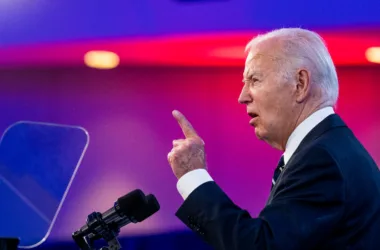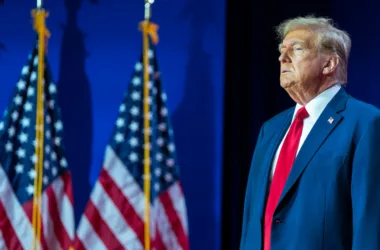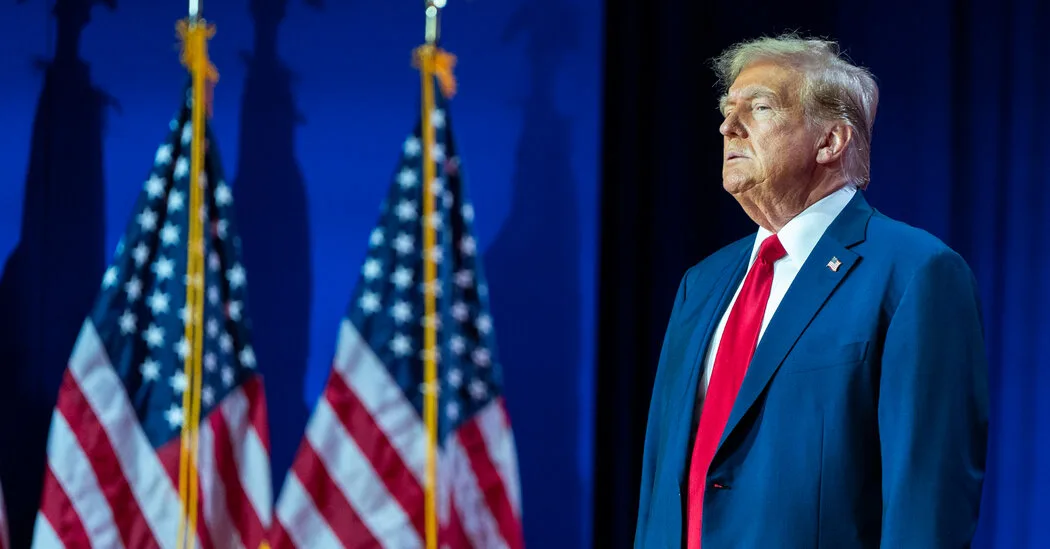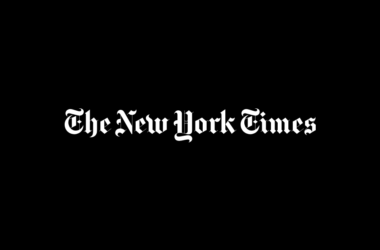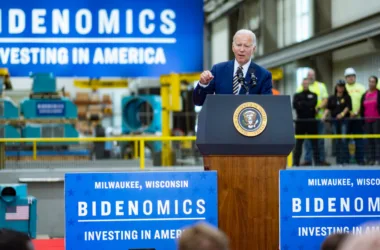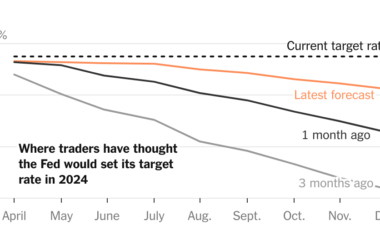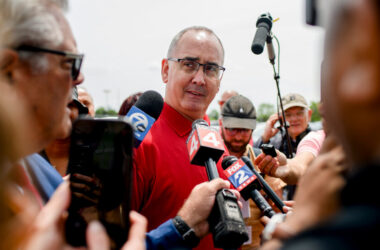In March 2018, a day after asserting sweeping tariffs on metals imported from America’s allies and adversaries alike, President Donald J. Trump took to social media to share one in all his central financial philosophies: “Commerce wars are good, and simple to win.”
As president, Mr. Trump presided over the most important enhance in U.S. tariffs because the Nice Despair, hitting China, Canada, the European Union, Mexico, India and different governments with stiff levies. They hit again, imposing tariffs on American soybeans, whiskey, orange juice and bikes. U.S. agricultural exports plummeted, prompting Mr. Trump to ship $23 billion to farmers to assist offset losses.
Now, as he runs for president once more, Mr. Trump is promising to ratchet up his commerce battle to a a lot larger diploma. He has proposed “common baseline tariffs on most overseas merchandise,” together with greater levies on sure nations that devalue their forex. In interviews, he has floated plans for a 10 percent tariff on most imports and a tariff of 60 percent or more on Chinese language items. He has additionally posited reducing the federal earnings tax and counting on tariffs for income as an alternative.
Mr. Trump, who as soon as proclaimed himself “Tariff Man,” has lengthy argued that tariffs would increase American factories, finish the hole between what America imported and what it exported and enhance American jobs.
His first spherical of levies hit greater than $400 billion price of imports, together with metal, photo voltaic panels, washing machines and Chinese language items like good watches, chemical compounds, bicycle helmets and motors. His rationale was that import taxes would revive American manufacturing, cut back reliance on overseas items and permit U.S. firms to raised compete towards low-cost merchandise from China and different nations.
Economists say the tariffs did cut back imports and inspired U.S. manufacturing facility manufacturing for sure industries, together with metal, semiconductors and pc gear. However that got here at a really excessive value, one which probably offset any total positive factors. Research present that the tariffs resulted in higher prices for American customers and factories that depend upon overseas inputs, and reduced U.S. exports for sure items that had been topic to retaliation.
Mr. Trump is now envisioning taxing maybe 10 occasions as many imports as he did throughout his first time period, an method that economists say might set off a commerce battle that drives up already excessive costs and plunges the U.S. right into a recession.
David Autor, an economics professor on the Massachusetts Institute of Expertise, stated the proposals would have “a really giant impact on costs nearly instantly.”
“I don’t assume they’ll do it,” Mr. Autor stated. “It might simply trigger a recession.”
In a current letter, 16 Nobel Prize-winning economists wrote that they had been “deeply involved” in regards to the dangers a second Trump administration posed to the economic system, inflation and the rule of regulation.
“We imagine {that a} second Trump time period would have a unfavorable impression on the U.S.’s financial standing on the earth and a destabilizing impact on the U.S.’s home economic system,” they wrote.
Mr. Trump and his supporters have a way more optimistic view of tariffs, arguing that they function leverage with overseas governments, cut back the commerce deficit with China and outcome within the progress of U.S. manufacturing jobs.
“I occur to be a giant believer in tariffs as a result of I feel tariffs offer you two issues: They provide you financial achieve, however additionally they offer you political achieve,” Mr. Trump stated on a recent podcast.
Karoline Leavitt, the Trump marketing campaign nationwide press secretary, stated in a press release that “the American folks don’t want nugatory out-of-touch Nobel Prize winners to inform them which president put extra money of their pockets.”
“President Trump constructed the strongest economic system in American historical past,” she stated. “In simply three years, Joe Biden’s out-of-control spending created the worst inflation disaster in generations.”
Jamieson L. Greer, a companion within the worldwide commerce workforce at King & Spalding, who was concerned with China commerce negotiations through the Trump administration, stated the view of Trump officers was that tariffs “might help assist U.S. manufacturing jobs particularly, particularly to the extent that they’re remediating an unfair commerce apply.”
China has lengthy engaged in insurance policies that drawback American employees, however different nations even have unfair commerce and tax insurance policies or misaligned currencies, Mr. Greer stated.
“In the event you stage out that taking part in subject, it makes it in order that Individuals don’t need to compete unfairly,” he stated.
Mr. Trump’s tariffs have home supporters among the many industries which have benefited from them. And President Biden gave them his personal stamp of approval by selecting to maintain Mr. Trump’s China tariffs in place whereas including a few of his personal, together with on electrical vehicles, metal and semiconductors.
However a number of the industries that had been hit hardest by Mr. Trump’s commerce wars aren’t trying ahead to a sequel. Executives in sectors like retail and spirits fear that one other spherical of tariffs might reignite tensions, increase their prices and once more shut off essential markets overseas.
Spirit exports to Europe declined by 20 p.c after the European Union imposed a 25 p.c retaliatory tariff on American whiskey in response to the Trump administration’s tariffs on metal and aluminum. And the China tariffs elevated the costs that retailers needed to pay for his or her merchandise, forcing them to both increase costs for his or her clients or minimize into their income.
“We want a commerce coverage, not simply extra tariffs,” stated David French, government vice chairman of presidency relations on the Nationwide Retail Federation. His group, which represents shops, e-commerce websites and grocers, ran a tv advert marketing campaign opposing the Trump tariffs in 2018. “All they’ve completed is add friction to the availability chain and value customers $220 billion.”
“Former President Trump appears at commerce as some kind of zero-sum sport — in the event you win, I lose and vice versa,” Mr. French stated. “That’s actually not the way in which commerce works.”
The facility of tariffs to assist or hinder exports is evident in industries that ultimately received a reprieve. In 2021, whiskey tariffs had been quickly suspended as a part of a deal the Biden administration made with the European Union. American whiskey exports to the bloc rose from $439 million in 2021 to $705 million final yr.
Chris Swonger, the chief government of the Distilled Spirits Council of the USA, stated he was hopeful that, if re-elected, Mr. Trump would admire that sturdy exports of American spirits would assist obtain his aim of lowering the commerce deficit. The lobbying group desires the E.U. tariff suspension, which expires subsequent March, to be prolonged.
“For President Trump, clearly we admire and respect his efforts to scale back the commerce deficit,” stated Mr. Swonger, who has made his case to Trump marketing campaign officers. “Imposing tariffs on distilled spirits could be counter to lowering the commerce deficit.”
Analysis suggests the tariffs did accomplish their aim of accelerating home manufacturing within the industries they protected, however did so by imposing different prices on the U.S. economic system.
One nonpartisan government study discovered that the tariffs on overseas metal and aluminum elevated U.S. manufacturing of these metals by $2.2 billion in 2021. However American factories that use metal and aluminum to make different issues, like vehicles, tin cans and home equipment, needed to pay greater prices for his or her supplies, and that diminished the output of these factories by $3.5 billion in the identical yr.
Research recommend the tariffs additionally had a combined document when it got here to jobs. In a current paper, Mr. Autor and different economists discovered that the cumulative impact of Mr. Trump’s commerce insurance policies and different nations’ retaliation was barely unfavorable for American jobs, or at greatest a wash.
When it comes to inflation, studies have estimated that American households confronted greater costs because of the tariffs — from a number of hundred {dollars} to greater than $1,000 yearly.
However economists say customers most likely didn’t affiliate the upper costs they paid with the tariffs, on condition that inflation was low all through Mr. Trump’s tenure and the economic system was sturdy.
Whereas the economic system stays strong, costs have spiked since 2021, and inflation stays elevated. That might make tariff-induced worth will increase extra apparent and extra painful this time round.
A recent analysis by the Peterson Institute of Worldwide Economics discovered that if Mr. Trump did impose a ten p.c tariff on all items and a 60 p.c tariff on China, it will value a typical family in the course of the earnings distribution about $1,700 in elevated bills annually.
One other evaluation, by the right-leaning American Motion Discussion board, estimated {that a} 10 p.c tariff might impose extra annual prices of as much as $2,350 per American family. Including a 60 p.c tariff on China would add one other $1,950 to U.S. family prices.
The burden of these tariffs would fall extra closely on poorer households, as a result of they spend a bigger share of their earnings on on a regular basis merchandise.
That might finally backfire on Mr. Trump, on condition that voter considerations about inflation are prime of thoughts.
As he waited in line to attend Mr. Trump’s rally on Saturday in Philadelphia, Paul Rozick, {an electrical} warehouse supervisor from Bensalem, Pa., stated excessive grocery and gasoline costs had outpaced his pay raises.
“Inflation goes up like 20 p.c, however our paychecks go up like 2 p.c,” Mr. Rozick stated. “I’ve acquired much less cash within the financial institution as a result of I’m spending extra money after I stroll out the door.”

